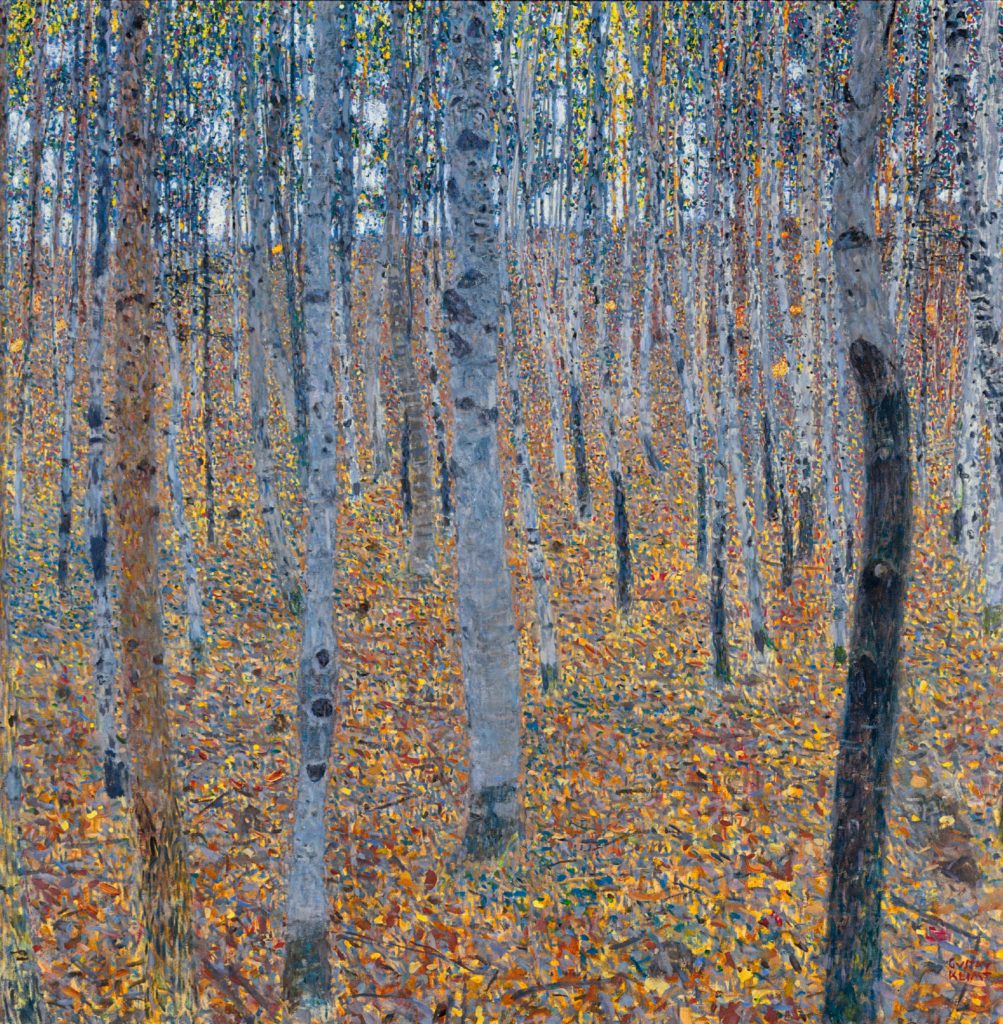Beech Grove I
The relaxing and restorative power of nature has become indispensable to many of us this past year, and it has moved me to integrate some of my thoughts and feelings into ‘painting of the month’ posts. January’s uncharacteristic venture into the 20th century has been inspired by the effect the outside world has on my physical and mental wellbeing, enhanced by the influences of music and poetry.
Beech Grove I (c.1902) by Gustav Klimt (1862-1918) is a beautiful painting. A square 100 x 100 cm, the canvas is covered with daubs and strokes of colour. The spindly beech tree trunks dictate the composition, creating a visually intricate labyrinth for the eye to navigate. This artwork conjures that immersive sensation of walking through a dense wood. Rather than blocking or impeding the viewer’s experience, the numerous vertical trunks induce a quiet reverence and calm. The peeling silvery tree bark, created by thinly applied layers of oil paint, defy solidity and prevent an imposing atmosphere.
While Klimt is not primarily known for his landscapes, the familiar textures of his more famous works are here. He has woven the paint into a richly multicoloured tapestry of leaves, bark and light. Repetitive and undulating brushstrokes create pattern and movement. The woodland floor dominates the canvas proportionally, taking up more than ¾ of the surface. What at first seems akin to a Magic Eye picture is penetrable upon close inspection. The thick carpet is covered with leaves and peppered with twigs and patches of grass. Although the tops of the trees in the foreground grow beyond the canvas edge, the canopy of those in the distance is a mosaic of paint, smatterings of pure yellow suggest sunlight breaking through.
The painting is not a conventional landscape in that it lacks a vanishing point. In fact, Klimt has placed a thick tree trunk in the centre of the canvas, blocking the point at which the sky meets the horizon. While we can see the powdery blue of the sky beyond, our eye cannot settle anywhere in the painting. Painting en plein air, Klimt used a viewfinder to compose his landscapes and must have intended to heighten the physical feeling one gets from being in nature, walking off the beaten path and meandering between the trees, finding a way of one’s own.
I would not describe myself as an outdoorsy person, quite the opposite in fact. Yet the benefits of a daily walk have become evident to me recently. The delight in feeling the sun on my face or watching a squirrel scurry up a tree about has almost been revelatory. Silver linings have been found while working indoors every day, as I have enjoyed watching the seasons changing from my window and rediscovered my love of music. The album Seven Days Walking by Ludovico Einaudi (2019) has been on repeat throughout the lockdown periods, providing encouragement to creative contemplation and aiding focussed concentration. I am trying to make 2020’s New Year’s resolution a permanent daily ritual, taking time each day to read some poetry. William Sieghart’s Poetry Pharmacy books have provided a much-needed balm to the emotional frustrations of recent times, as well as a springboard for personal reflection. One poem has really helped my ongoing struggle to feel gratitude and contentment, which I will close with:
From The Hymn of Empedocles by Matthew Arnold
Is it so small a thing
To have enjoy’d the sun,
To have lived light in the spring,
To have loved, to have thought, to have done…?[1]
[1] Seighart, William. The Poetry Pharmacy Returns: More Prescriptions for Courage, Healing and Hope. Particular Books. 2019. p.49.

